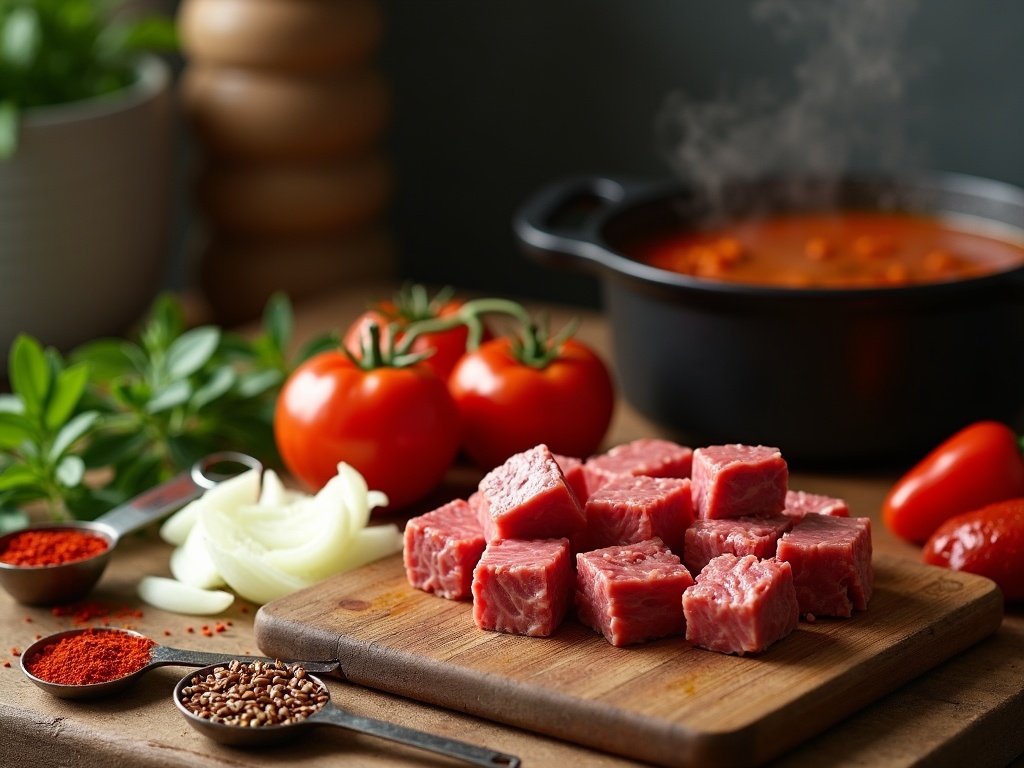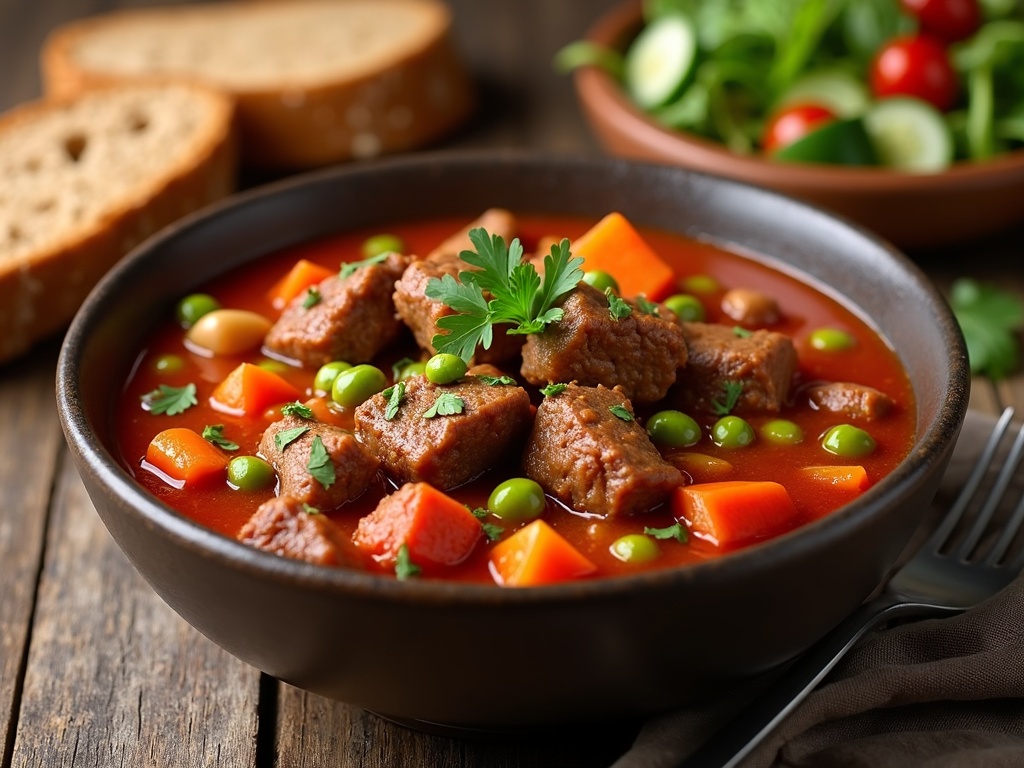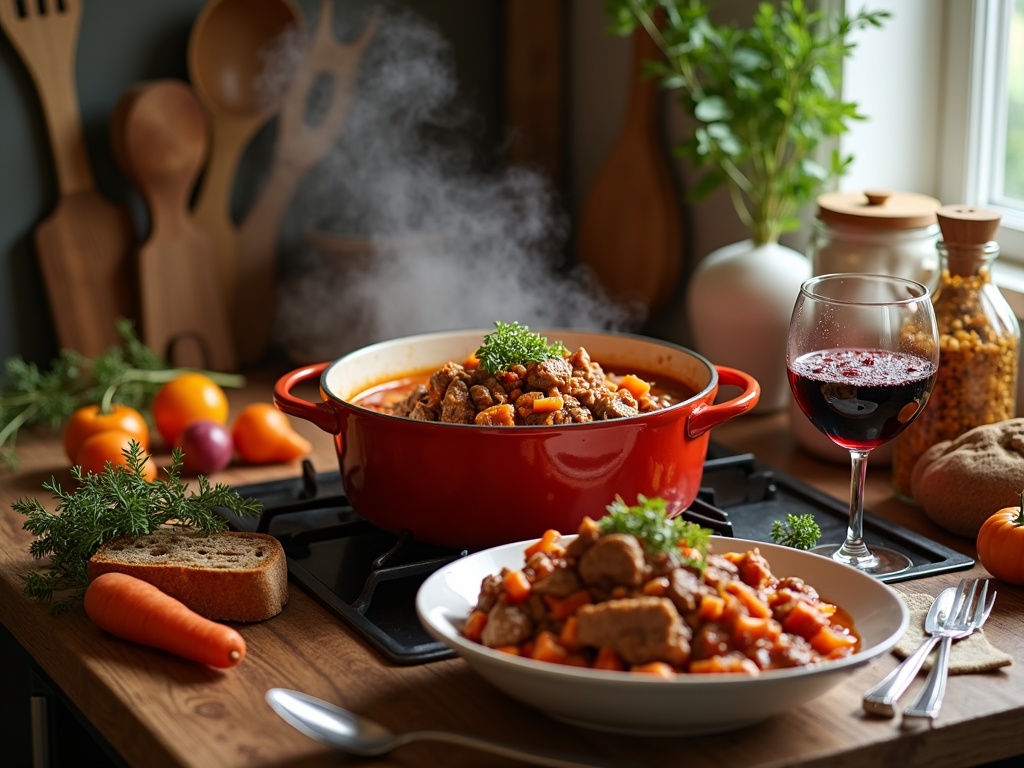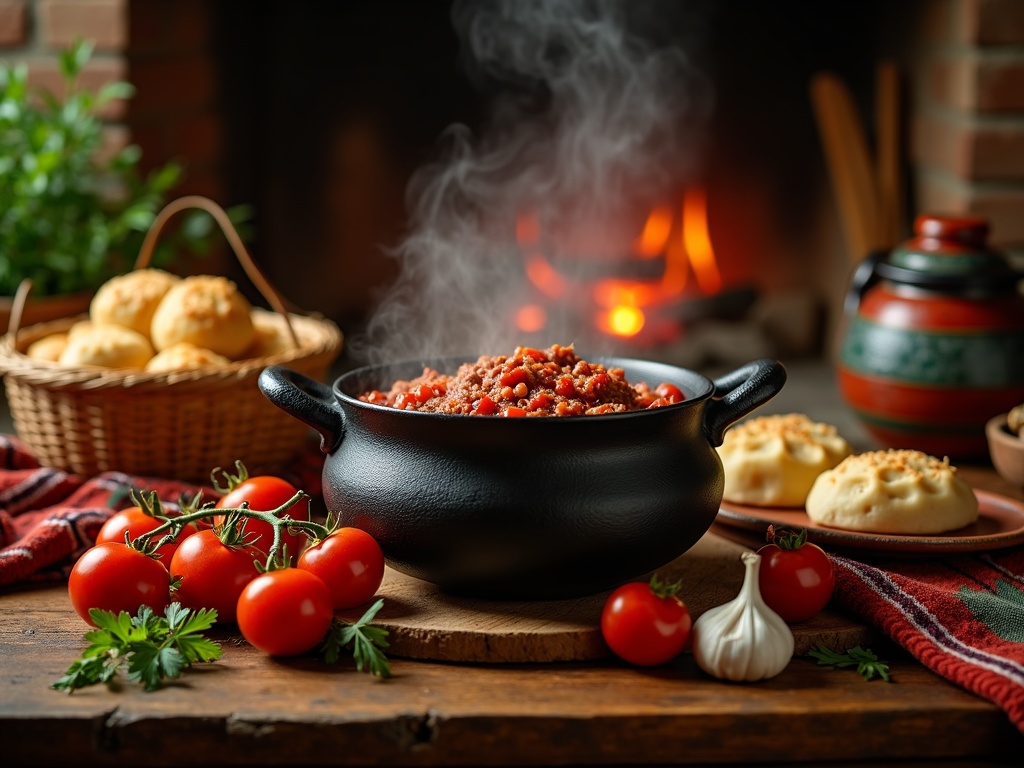Beef goulash started as a simple shepherds’ meal in Hungary but has risen to international fame as a Central European culinary masterpiece. Cattle herders first cooked this dish over open flames in the 9th century. It gradually shifted from a basic soup to the rich stew people enjoy today, with paprika becoming its defining ingredient during the 18th century.
Find In This Article
Key Takeaways
- Traditional beef goulash features tender beef chunks, onions, and paprika, slow-cooked for 2-3 hours to develop complex flavors.
- The dish traveled beyond Hungary during the Austro-Hungarian Empire, creating regional variations across Central Europe with each country adding local ingredients.
- Hungarian festivals celebrate goulash with cooking competitions where judges evaluate texture, flavor balance, and authenticity.
- Nutritionally, goulash provides 16-30g of protein per serving and contains beneficial antioxidants from paprika, along with essential vitamins and minerals.
- Classic accompaniments include crusty bread, egg noodles (nokedli), sour cream as a garnish, and pairing with Hungarian red wines or Czech lagers.
A Rich History of Hungary’s National Dish
The story of beef goulash begins with the nomadic Magyar shepherds who settled in Hungary during the 9th century. These shepherds, known as gulyás (cattle herdsmen), would prepare their meals in large cauldrons over open fires while tending their livestock on the vast Hungarian plains. I find it fascinating how this humble dish created by working people has evolved into one of the most celebrated culinary treasures of Central Europe.
Originally, these early versions were more like a soup than the thick stew many of us recognize today. The herdsmen would dry meat and other ingredients, carrying them in bags made of sheep’s stomachs. When it was time to eat, they’d simply add water to create a nourishing meal that sustained them during long days in the fields.
From Peasant Food to National Pride
The traditional name gulyás gradually evolved into what we now know as goulash. What started as simple sustenance for shepherds transformed into Hungary’s national dish through centuries of refinement. By the late 18th century, goulash had made its way from rural campfires to urban households and eventually to the tables of nobility.
The dish gained international recognition during the height of the Austro-Hungarian Empire in the 19th century. As Hungarian influences spread across Europe, so did their beloved goulash. The empire’s vast territory, stretching from Austria to parts of present-day Ukraine, provided the perfect vehicle for this culinary ambassador.
Paprika, now the signature spice in beef casserole recipes like goulash, wasn’t actually added until the 18th century when it was imported from the Americas. Before this introduction, the dish relied primarily on black pepper and other local seasonings. Today, it’s impossible to imagine authentic goulash without the distinctive red color and flavor that paprika provides.
Regional Variations Across Central Europe
As goulash traveled beyond Hungary’s borders, it adapted to local tastes and ingredients, creating distinct regional variations:
- Czech goulash (guláš) tends to be thicker and served with bread dumplings
- Slovak versions often incorporate more vegetables and sometimes sauerkraut
- Austrian goulash typically uses more tomatoes and is served with spätzle
- German goulash frequently includes hearty ragu elements and sometimes beer in the broth
- Polish goulash might include wild mushrooms and sometimes juniper berries
Despite these variations, all maintain the core elements that make goulash instantly recognizable: tender beef, paprika, and a slow-cooking process that allows flavors to develop fully. The dish has become so popular that variations can be found as far as Belgium, Italy, and even Brazil, brought by Hungarian immigrants.
In Hungary itself, goulash remains deeply embedded in cultural identity. It appears at family gatherings, festivals, and national celebrations. The annual goulash festivals draw thousands of participants competing to create the most authentic and delicious version of this beloved dish. Many Hungarians still prepare it in traditional cauldrons (bogrács) over open fires, connecting modern cooks with centuries of culinary tradition.
Today, beef goulash stands as a delicious example of how homemade comfort foods can transcend their humble origins to become symbols of national pride. Whether you’re sampling it in a Budapest restaurant or preparing it in your own kitchen, each spoonful connects you to generations of Hungarian tradition and the ingenious shepherds who first created this remarkable dish on the open plains of Central Europe.
Perfect Your Goulash: Essential Ingredients and Techniques
Creating an authentic beef goulash requires understanding both traditional ingredients and proper techniques. This hearty stew originates from Hungary but has found its way into kitchens worldwide, with good reason.
Core Ingredients for Authentic Goulash
The foundation of any proper goulash starts with selecting the right ingredients. I always begin with quality beef chuck or shoulder cut into 1-inch cubes. These tougher cuts break down beautifully during cooking, releasing rich flavors and becoming tender.
Onions are equally important – I use at least two large onions for every pound of beef. They should be slowly caramelized until golden brown, creating a sweet foundation. Paprika is the defining spice, with 2-3 tablespoons needed for that characteristic deep red color and distinctive flavor.
Tomatoes add acidity and brightness to balance the richness. I prefer fresh tomatoes in summer, but good-quality canned tomatoes work perfectly year-round. Potatoes added during the final hour of cooking absorb the flavors while providing substance, though some regional versions omit them.
For authentic flavor, I never skip caraway seeds and fresh garlic. The caraway provides earthy notes that complement the paprika perfectly, while garlic adds depth without overpowering the dish.
Looking for more beef-based comfort foods? My hearty beef casserole recipe uses similar slow-cooking principles for tender, flavorful results.
Mastering Cooking Techniques
The magic of goulash happens in the cooking method. Traditional preparation requires patience – slow cooking for 2-3 hours develops complex flavors as the meat becomes fork-tender and the sauce thickens to the perfect consistency.
I start by browning the beef in batches, being careful not to overcrowd the pan. This crucial step creates flavor through caramelization. Next comes the slow cooking of onions until translucent, before adding paprika. Here’s an important tip: add paprika off the heat to prevent burning, which creates bitterness.
For those with less time, modern alternatives like pressure cooking produce excellent results in about 45 minutes. The key difference is in texture – pressure-cooked goulash tends to have a slightly different mouthfeel though the flavors develop nicely.
To achieve that tender meat and rich sauce:
- Brown meat thoroughly before slow cooking
- Don’t rush the onions – they need time to release their sweetness
- Add paprika off heat to prevent burning
- Maintain a gentle simmer, never a rolling boil
- Check seasoning toward the end of cooking
While beef is traditional, regional variations exist using different proteins. Some Hungarian regions use venison for a gamier flavor profile, while others substitute pork for a lighter taste. I’ve tried both and each brings its own character to the dish.
If you enjoy working with ground beef instead, my mince beef recipes offer similar comfort food appeal with less cooking time.
The type of paprika dramatically impacts the final result. Sweet (mild) paprika provides classic flavor, while hot paprika adds significant heat. For balance, I typically use mostly sweet with a small amount of hot paprika. Some recipes call for smoked paprika, which adds another dimension entirely.
For those who enjoy bold, spicy beef dishes, my homemade chili recipe uses similar slow-cooking principles with a different spice profile.
Goulash shares similarities with other beef stews from around the world. If you enjoy this dish, you might also appreciate the rich flavors of an Irish stew recipe or the complex sauce in my ragu recipe.

Health Benefits and Nutrition Facts
Beef goulash offers more than just delicious flavor – it packs a nutritional punch that makes it a smart addition to a balanced diet. When prepared with lean cuts of beef and plenty of vegetables, this hearty dish delivers substantial nutrition without excessive calories.
Macro and Micronutrient Profile
A typical cup serving of beef goulash contains between 250-350 calories, making it a reasonable option for main meals. The protein content ranges from 16-30g per serving, depending on the beef quantity used, which supports muscle maintenance and growth. I find this particularly valuable on days when I need sustained energy. The fat content typically falls between 15-20g, with much of it coming from the beef itself.
One of the standout nutritional features of goulash is the abundance of antioxidants from paprika. This vibrant spice doesn’t just add color and flavor – it contains capsaicin and vitamin E, which help fight oxidative stress in the body. The dish is also high in essential vitamins and minerals, including:
- Iron for healthy blood cell production
- Zinc to support immune function
- B vitamins for energy metabolism
- Potassium for heart health
- Selenium, an important antioxidant mineral
Creating a Balanced Meal
Beef goulash provides a source of complete protein, containing all essential amino acids your body needs but can’t produce on its own. This makes it particularly valuable for tissue repair and overall health maintenance.
To maximize the nutritional benefits, I often serve beef casserole dishes like goulash with additional vegetables or a side salad. This approach creates a well-rounded meal with a good balance of protein, carbohydrates, and healthy fats.
For those looking to boost the fiber content, consider adding extra vegetables like bell peppers and carrots, or serving your goulash with whole grain options like brown rice or whole wheat bread. If you enjoy hearty beef dishes, you might also appreciate trying a homemade chili recipe that offers similar nutritional benefits.
The combination of slow-cooked beef with nutrient-dense vegetables and aromatic spices makes goulash not just a comfort food favorite, but a genuinely nutritious choice that can fit into a health-conscious eating plan.

Traditional Serving Suggestions and Pairings
Nothing completes a hearty beef casserole like goulash quite like the perfect accompaniments. I’ve found that the right sides, garnishes, and beverages can transform this humble dish into a memorable feast.
Classic Accompaniments and Beverages
Beef goulash traditionally pairs with several classic sides that help soak up its rich sauce. Crusty bread is perhaps the simplest option – tear off chunks to mop up every last drop of that paprika-laden gravy. For something more substantial, fluffy dumplings are a Central European favorite, acting as the perfect vehicle for the sauce. Egg noodles (called nokedli in Hungary) provide a tender base that cradles the goulash beautifully, similar to how pasta works with a good ragu recipe.
For beverages, the robust flavors of goulash call for equally bold drinks:
- Full-bodied red wines like Hungarian Bull’s Blood (Egri Bikavér)
- Czech or Hungarian lagers that cut through the richness
- For the authentic experience, try Hungarian Pálinka (fruit brandy) as a digestif
Traditional garnishes add both visual appeal and flavor contrast to goulash:
- A dollop of sour cream helps balance the heat and adds creaminess
- Fresh parsley sprinkled on top provides color and a hint of freshness
- Some regions add a touch of lemon zest for brightness
Regional variations showcase how this dish evolved across borders. In Austria, goulash is often served alongside spätzle (small dumplings), while Czech variations might include knedlíky (bread dumplings). Some Hungarian families serve it with pickled vegetables on the side, creating a tangy contrast to the minced beef recipes like goulash.
For authentic presentation, I serve goulash in deep bowls rather than plates to hold the abundant sauce. In Hungary, it’s often brought to the table in the cooking pot itself – typically a heavy cast iron vessel – keeping it piping hot and creating a rustic, communal dining experience reminiscent of its origins as a homemade chili-like stew made by cattle herders over open flames.
The robust flavors of goulash also pair wonderfully with simple green salads dressed with vinegar and oil, creating a refreshing counterpoint to the rich, warming stew that shares distant cousins with Irish stew recipes and Asian-inspired beef broccoli dishes.
Making it Festival-Worthy
Beef goulash holds a special place in Hungarian cultural celebrations, often taking center stage at festivals across the country and beyond. I’ve learned that a truly authentic goulash can transform an ordinary gathering into a memorable cultural experience. The rich paprika-infused stew has become synonymous with Hungarian heritage and is often the highlight of food-focused events.
From Competition to Celebration
At Hungarian cultural festivals, goulash competitions draw passionate cooks eager to showcase their skills. The dish becomes more than food—it’s a source of national pride and friendly rivalry. Competition judges typically focus on several key elements:
- Texture of the beef (tender but not falling apart)
- Depth and balance of the paprika flavor
- Consistency of the sauce (not too thin or thick)
- Authentic preparation techniques (like using a traditional cauldron)
- Overall harmony of flavors without any single ingredient dominating
The secret to a competition-winning beef casserole like goulash often lies in the details. Award-winning variations sometimes include unexpected touches—a hint of caraway seeds, the addition of roasted bell peppers, or even a splash of red wine for depth. However, purists maintain that the most celebrated recipes stick closely to tradition, allowing the quality ingredients to shine.
When I’ve attended these festivals, I’ve noticed that winning cooks often focus on two critical elements: patience and quality ingredients. The slow-cooking process allows flavors to develop fully, while premium-quality paprika makes a noticeable difference that judges reward. Some winners recommend toasting the paprika briefly in the pot’s residual heat before adding liquid—a technique that develops complex flavors without burning this delicate spice.
Scaling for Celebrations
A homemade chili or goulash makes the perfect centerpiece for family gatherings, but scaling up requires careful consideration. When cooking for large groups, I’ve found these approaches particularly helpful:
- Calculate approximately 8-10 ounces of raw beef per person
- Maintain the proper ratio of paprika to meat (generally 1-2 tablespoons per pound)
- Use multiple pots if necessary rather than overcrowding one large pot
- Prepare the dish a day ahead to allow flavors to develop even further
- Serve with a variety of sides to accommodate different preferences
For truly large gatherings, preparation becomes crucial. Making the dish 24-48 hours ahead allows the flavors to meld beautifully and takes pressure off day-of cooking tasks. The robust mince beef recipes like goulash actually improve with time as the spices permeate the meat more thoroughly.
I’ve discovered that serving goulash at room temperature rather than piping hot can sometimes showcase the complex flavors better—a trick used by festival veterans. This approach also simplifies service for large groups, as you don’t need to worry about keeping multiple pots at precise temperatures.
Another festival-worthy tip involves presentation. Traditional Hungarian serving includes presenting the goulash in a cauldron or decorative pot, accompanied by small bowls of additional toppings like extra sour cream, chopped herbs, or hot chili peppers for those who enjoy extra heat. This interactive serving style adds a festive touch to the meal and allows guests to personalize their portions.
The versatility of goulash makes it perfect for cultural celebrations. Its rich heritage connects to Irish stew recipe traditions in the sense that both represent culturally significant dishes that bring people together around shared culinary customs. Like its ragu recipe cousins from Italy, goulash demonstrates how slow-cooked meat dishes transcend borders while maintaining their distinctive regional characteristics.
For a truly impressive presentation, consider serving your festival-worthy goulash with traditional accompaniments like nokedli (Hungarian dumplings), cucumber salad, or even a beef broccoli side dish for added vegetable content and color contrast.
Expert Tips for Perfect Results
I’ve discovered that the right techniques make all the difference when preparing a mouth-watering beef goulash. Getting those tender chunks of beef and the perfect paprika-infused sauce requires some know-how that I’m happy to share.
Selecting the Best Ingredients
The foundation of exceptional goulash starts with the right cut of beef. Chuck or shoulder cuts work beautifully because their collagen-rich fibers break down during slow cooking, resulting in melt-in-your-mouth meat. These affordable cuts actually deliver more flavor than expensive ones when properly braised. If you enjoy working with ground beef, you might also appreciate these versatile minced beef recipes for other meal options.
Paprika selection is crucial – I recommend Hungarian sweet paprika for authentic flavor. Store your paprika in an airtight container away from light and heat to preserve its vibrant color and taste. Fresh paprika makes a noticeable difference in your goulash, similar to how quality spices elevate a homemade chili.
Perfecting the Cooking Process
The magic of goulash happens through slow cooking. I maintain a gentle simmer at around 325°F (165°C) for oven methods or low setting for slow cookers. This gives the beef 2.5-3 hours to become perfectly tender. Rushing this process results in tough meat, while overcooking can make it mushy.
Common problems and solutions include:
- Too runny sauce: Simmer uncovered for 15-20 minutes to reduce.
- Tough meat: Continue cooking at low temperature; it likely needs more time.
- Bland flavor: Add more paprika and a splash of red wine vinegar.
- Burning: Lower your heat and stir more frequently.
For make-ahead convenience, goulash actually improves with time as flavors meld together. I store it in the refrigerator for up to 3 days in an airtight container. The slow-cooking approach reminds me of techniques used in beef casserole or Irish stew recipes, where patience yields the best results.
When freezing, I cool the goulash completely before transferring to freezer-safe containers, where it keeps for up to 3 months. For reheating, I thaw overnight in the refrigerator then warm gently on the stovetop, adding a splash of broth if needed to maintain the sauce consistency. This makes goulash perfect for meal prep, similar to a good ragu recipe or beef and broccoli that can be prepared in advance.

Sources:
Food Network, History of Goulash
National Geographic, Culinary Journey Through Hungary
USDA FoodData Central
Hungarian Food Guide, Gulyás History

